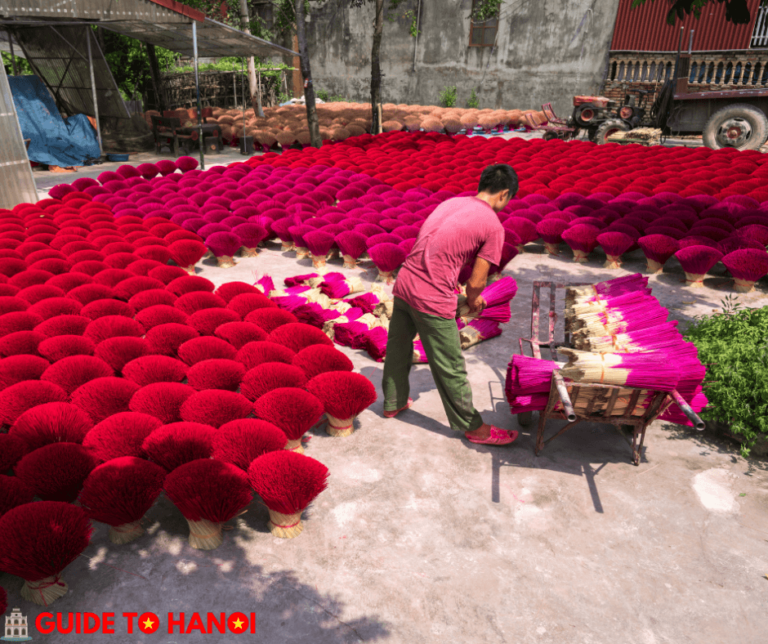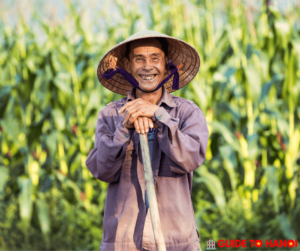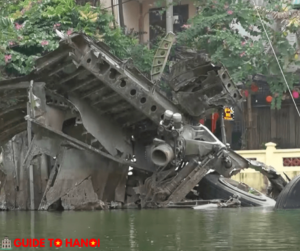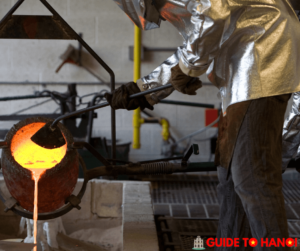Incense Village (Quảng Phú Cầu)
Nestled in Ung Hoa district, Hanoi, Incense Village (Quảng Phú Cầu) is a picturesque commune spread over 8.91 km2, boasting six charming villages: Xa Cau, Quang Nguyen, Phu Luong Thuong, Phu Luong Ha, Cau Bau, and Dao Tu.
Surrounded by Phu Tuc commune, Hong Duong commune, and Truong Thinh and Lien Bat communes, this village offers a glimpse into rural Vietnam’s natural beauty and cultural heritage.
With a population of 11,143 as of 2012, the commune is a vibrant hub of life and traditions.
An Instagram Photo location
Nestled amidst the rustic charm of Vietnam’s countryside, Incense Village (Quảng Phú Cầu) is a hidden gem that beckons Instagram users with its picturesque landscapes and rich cultural heritage-
No wonder the day tour to the village from Hanoi is top-rated among Instagrammers.
The village’s lush greenery, tranquil rivers, and ancient temples offer the perfect backdrop for stunning photos.
Capture the vibrant colors of traditional incense-making, the intricate architecture of communal houses, or the serene beauty of the countryside.
Whether you’re exploring the narrow lanes lined with old houses or admiring the reflections in the tranquil waters, every corner of Incense Village is a photographer’s dream.
Immerse yourself in the timeless beauty of this village and create unforgettable memories to share with the world.
An Ode to History
It was formed from the merger of three communes—Quang Nguyen, Phu Luong, and Xa Cau—Quang Phu Cau boasts a rich history dating back to ancient times.
Legends speak of its founding chiefs and their noble deeds, highlighting the commune’s deep roots in Vietnamese history.
A Sanctuary of Culture
The village’s cultural traditions are deeply ingrained, with a strong emphasis on education and patriotism.
With a long-standing tradition of scholarly pursuit, the village has produced many scholars and intellectuals throughout its history.
Its patriotic spirit is evident in its resistance against invaders, with notable figures like Mrs. Chieu Nuong and revolutionary Tran Dang Ninh emerging from its soil.
A Thriving Economy
Quang Phu Cau’s economy thrives on traditional crafts, particularly incense stick production.
With over 13,000 residents, the commune’s economy is primarily driven by incense sticks and scrap collection.
Traditional craft villages produce various products, including VIP toothpicks and incense, for spiritual purposes, contributing significantly to the local economy.
The Incense Industry: A Fragrant Legacy
The incense industry in Quang Phu Cau is a significant economic driver, attracting workers from across the region.
The production of incense sticks, VIP toothpicks, and incense for spiritual purposes has transformed the commune into a bustling hub of activity, with modern factories and skilled workers driving its growth.
Preserving the Past, Embracing the Future
As Quang Phu Cau continues to evolve, it remains committed to preserving its rich Vietnamese cultural heritage while embracing modernity.
With a strong sense of community and a deep-rooted connection to its past, the commune is poised to write new chapters in its storied history.
Plan Your Visit to Incense Village
Experience the charm of Incense Village (Quảng Phú Cầu) and immerse yourself in its rich culture and history.
Explore the picturesque landscapes, learn about its traditional crafts, and connect with warm and welcoming residents.
Whether you’re a history buff, a nature lover, or simply looking for a unique experience, Incense Village has something for everyone.
Book a day tour from Hanoi!
Experience the allure of Incense Village (Quảng Phú Cầu) with our exclusive day tour from Hanoi.
Immerse yourself in the beautiful charm of rural Vietnam as you explore ancient temples, witness traditional incense-making, and soak in the breathtaking scenery.
Book the day tour now for an unforgettable and Instagramic adventure in the heart of Vietnam’s countryside!

| Incense Village (Quảng Phú Cầu) | |
|---|---|
| Location | Ung Hoa district, Hanoi, Vietnam |
| Area | 8.91 km² |
| Population | 11,143 (2012) |
| Main Attractions | Ancient temples, traditional incense-making, picturesque landscapes |
| Connectivity | Accessible via National Highway 21B and Road 429A |
| Economy | A thriving economy with a focus on incense production |
| Cultural Significance | Rich history, strong emphasis on education, and patriotism |
| Book Your Day Tour from Hanoi | |
How do I get from Hanoi to incense village?
To visit Incense Village (Quảng Phú Cầu) as part of a day tour from Hanoi, you can book a tour with a local travel agency or join a group tour.
These tours typically include transportation from Hanoi to the village and back and a guided tour of the village’s attractions, such as ancient temples and traditional incense-making workshops.
The day tour usually starts early in the morning from Hanoi. It returns in the evening, allowing you to experience the beauty and culture of Incense Village in a single day.
This option is convenient for travelers who want to explore the village without worrying about transportation or itinerary planning.
Other options
You can also take a taxi, a motorbike, or a private car. The village is in the Ung Hoa district, about 30 kilometers from Hanoi’s city center.
The journey usually takes 1 to 1.5 hours, depending on traffic conditions.
If you prefer public transportation, you can take a bus from Hanoi to Ung Hoa district and then transfer to a local bus or taxi to reach Incense Village.
However, this option may take longer and be less convenient than a taxi or private car.
It’s advisable to arrange your transportation in advance to ensure a smooth and hassle-free journey to Incense Village.
Is incense Village worth visiting?
Yes, Incense Village (Quảng Phú Cầu) is worth visiting!
It offers a unique and authentic experience of rural Vietnam, with its ancient temples, traditional incense-making, and picturesque landscapes.
The village’s rich history and cultural significance make it a fascinating destination for those looking to explore off the beaten path.
Whether you’re interested in history and culture or want to immerse yourself in the countryside’s natural beauty, Incense Village has something for everyone.
Plus, with its proximity to Hanoi, it’s a convenient day trip destination for travelers looking to escape the hustle and bustle of the city.
Where can I see incense in Vietnam?
In Vietnam, incense is used in various religious and cultural contexts.
Here are some places where you can experience the use of incense:
Temples and Pagodas:
Buddhist temples and pagodas across Vietnam use incense in their rituals and ceremonies.
Large incense coils or sticks are burning in front of altars and shrines as offerings to deities and ancestors.
Traditional Craft Villages:
Visit villages like Incense Village (Quảng Phú Cầu) near Hanoi, where traditional incense-making is still practiced.
Here, you can observe the process of making incense sticks and learn about the cultural significance of incense in Vietnamese society.
Festivals and Celebrations:
Incense plays a significant role in Vietnamese rituals and traditions during festivals and special occasions, such as the Lunar New Year (Tet).
You can see incense burned at temples, pagodas, and homes to pray for good luck and prosperity.
Markets and Shops:
In many markets and shops across Vietnam, you can find various products for sale, including incense sticks, cones, and coils.
These are often used at home or as gifts for special occasions.
Overall, incense is deeply ingrained in Vietnamese culture and religion, and you can experience its beauty and significance in many aspects of daily life across the country.
How far is Hanoi from incense Village?
Hanoi is approximately 30 kilometers (about 18.6 miles) from Incense Village (Quảng Phú Cầu).
The distance can be covered by car in about 1 to 1.5 hours, depending on traffic conditions and the mode of transportation.
Quang Phu Cau enjoys excellent connectivity, with National Highway 21B and Road 429A passing through it, linking it to Ha Dong, Van Dinh, Hoa Binh, Ha Nam, and Phu Xuyen.
The Nhue River to the north and the North Quang Hoa Canal facilitate economic and cultural exchanges, adding to the village’s historical significance.




